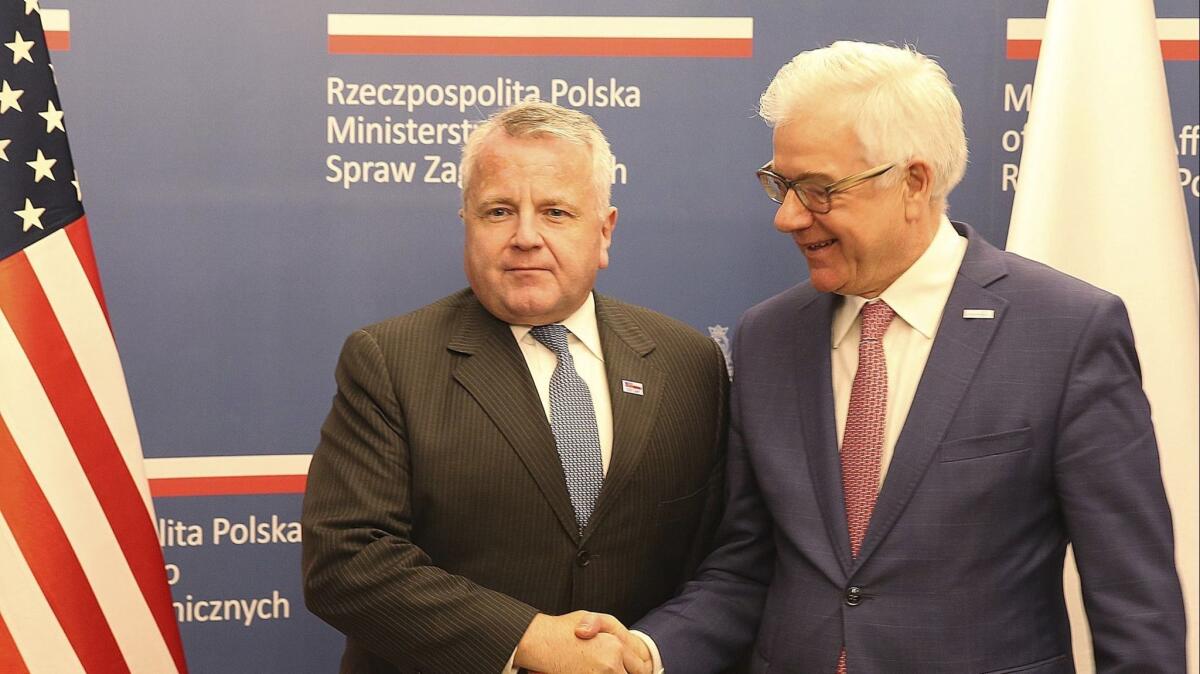Sempra signs deal with Poland, bolstering its plan to build LNG plant in Texas
- Share via
Reporting from San Diego — Sempra Energy finalized a 20-year deal with Poland’s national oil and natural gas company Wednesday — a deal that the San Diego company hopes will help it become a major world player and that bolsters Sempra’s plan to build a liquefied natural gas facility on the Texas Gulf Coast.
Polish Oil and Gas Co. signed a sale-and-purchase agreement with Sempra to take 2 million tons of liquefied natural gas, or LNG, per year. That’s enough to meet about 15% of Poland’s daily natural gas needs, and it’s about 20% of the export capacity at the proposed facility near Port Arthur, Texas.
The agreement takes effect only if Sempra builds the facility.
Joseph Householder, Sempra’s president and chief operating officer, said the agreement will build momentum and prompt other customers to jump on board. Korea Gas Corp., South Korea’s state-owned natural gas supplier and the world’s second-largest importer of LNG, agreed to establish a framework with Sempra last year on the Port Arthur facility.
“I think what will happen here is some of the people we’ve been talking to for a while … will start saying, ‘Uh oh, we’ve got to sign because we need to make sure that we don’t get lost in the shuffle,’” Householder said. “This is a big announcement for us because it really helps drive the Port Arthur facility.”
A final decision to build the Port Arthur project has not been made, but Sempra expects to get a permit from the Federal Energy Regulatory Commission finalized by the end of the first quarter of 2019.
If the project becomes a reality, the deal signed with Poland will begin in 2023.
Through the liquefaction process, natural gas is cooled to minus 260 degrees Fahrenheit and turned into liquid. It can then be transported in containers. At its destination, the LNG is turned back into a gas.
Along with partners based in France and Japan, Sempra is already building another massive LNG facility on the Gulf Coast — in Lousiana — called the Cameron LNG facility. The $10-billion project’s first shipment of LNG to international customers is expected by the middle of next year.
Sempra also wants to expand an LNG facility near Ensenada, Mexico, operated by its Mexican subsidiary, to include an export component to ship natural gas to growing markets in Japan, China and other Asian countries.
The company has set a long-term goal of exporting 45 million tons of LNG a year to customers around the globe.
For Poland, the deal with Sempra marks a step toward becoming less dependent on natural gas from Russia. Poland signed similar agreements with Venture Global in October and Cheniere Energy last month. The Polish oil and gas company also said Wednesday that it plans to expand its LNG import terminal in the port city of Świnoujście.
“Another long-term contract not only allows us to develop an LNG portfolio with a view to delivering to Poland,” Piotr Wozniak, Poland’s oil and gas company president, said in a statement, “but it gives us, in the near future, the possibility of trading in LNG purchased on a global scale.”
The Trump administration has been promoting American LNG to markets in Europe as a way to boost U.S. industry, reduce the trade deficit and exert some leverage on Russia.

“Anytime you can diversify to offset any potential negative implications with a certain geography or a certain country is probably a smart move,” said Andy Smith, a senior analyst who follows utilities for Edward Jones. “And it’s a smart move price-wise, too, because you can try to play one against the other and get the best price for your product.”
Until recent years, the LNG export market in the United States was practically nonexistent. But due to hydraulic fracturing and horizontal drilling techniques in places such as the Marcellus Shale in the East and the Permian Basin in west Texas and southeastern New Mexico, domestic production has taken off.
rob.nikolewski@sduniontribune.com
Nikolewski writes for the San Diego Union-Tribune.
More to Read
Inside the business of entertainment
The Wide Shot brings you news, analysis and insights on everything from streaming wars to production — and what it all means for the future.
You may occasionally receive promotional content from the Los Angeles Times.










